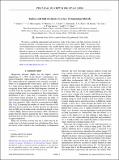Surface and bulk electronic structure of aluminium diboride
Abstract
We report a combined experimental and theoretical study of the surface and bulk electronic structure of aluminium diboride, a non-superconducting sister compound of the superconductor MgB2. We perform angle-resolved photoemission measurements with variable photon energy, and compare them with density functional theory calculations, in order to disentangle the surface and bulk contributions to the measured spectra. Aluminium diboride is known to be aluminium deficient, Al1−δB2, which would be expected to lead to a hole doping as compared to the nominally stoichimoetric compound. Nonetheless, we find that the bulk σ states, which mediate superconductivity in MgB2, remain more than 600meV below the Fermi level. However, we also observe σ states originating from the boron terminated surface, with an order of magnitude smaller binding energy of 70meV, and demonstrate how surface hole-doping can bring these across the Fermi level.
Citation
Sunko , V , Milosavljević , D , Mazzola , F , Clark , O J , Burkhardt , U , Kim , T K , Rosner , H , Grin , Y , Mackenzie , A & King , P 2020 , ' Surface and bulk electronic structure of aluminium diboride ' , Physical Review. B, Condensed matter and materials physics , vol. 102 , 035143 . https://doi.org/10.1103/PhysRevB.102.035143
Publication
Physical Review. B, Condensed matter and materials physics
Status
Peer reviewed
ISSN
1098-0121Type
Journal article
Description
Funding: We acknowledge support from the European Research Council (grant no. ERC-714193 QUESTDO), the Royal Society and the Max Planck Society. V.S. and O.J.C acknowledge EPSRC for PhD studentship support through grant numbers EP/L015110/1 and EP/K503162/1, respectively. D. M. acknowledges support from the International Max Planck Research School for Chemistry and Physics of Quantum Materials (IMPRS-CPQM).Collections
Items in the St Andrews Research Repository are protected by copyright, with all rights reserved, unless otherwise indicated.

